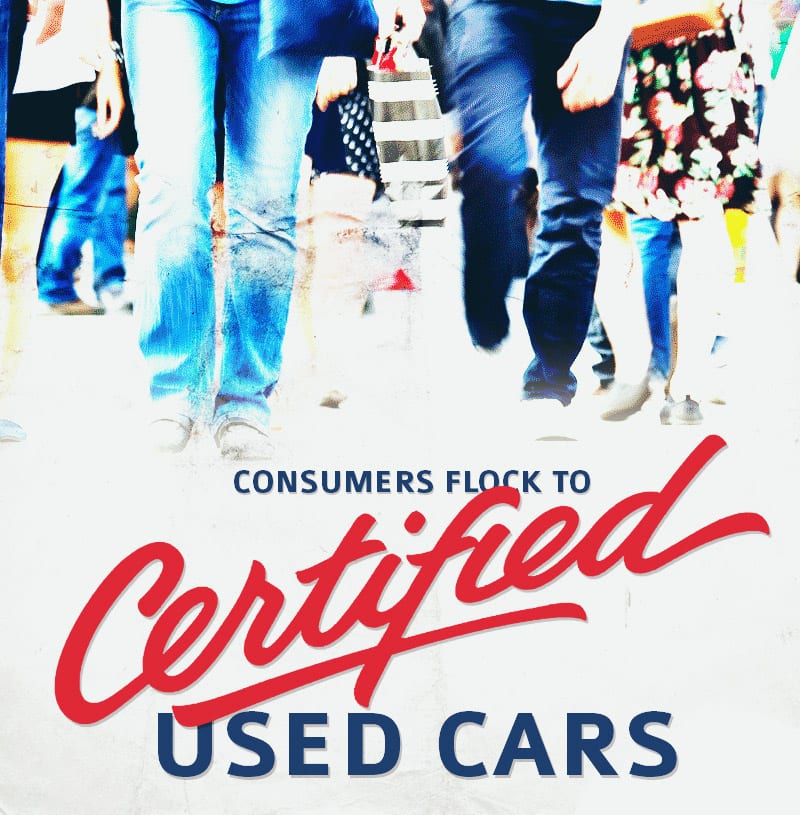Buyers are flocking to the certified used car market, buying CPO cars left and right. A recent survey from Edmunds shows that out of more than 2,000 adults, 88% of those adults said they would pay more for a certified-pre owned car than one that wasn’t certified. As opposed to buying one of the non-certified used cars found on the side of the road or in other used car lots. The CPO (Certified Pre-Owned) market used to be reserved for mainly luxury vehicles; consumers would buy the expensive luxury cars for a cheaper price than getting them new, but those days are over. Now, there is a plethora of mainstream models swarming dealer lots as they come off lease. They are making up a big portion of the CPO traffic, and the CPO market is at an all-time high.
People have begun to recognize the benefit of spending the extra money on a CPO car.
History Repeats Itself
Back in the 1990s, dealers were receiving an increasing number of returned lease cars. The manufacturer did not bother reselling them, until they realized the profit they were losing. They realized that most of the leased cars coming back were in great mechanical condition, the only “issue” being an expected increase in mileage. After realizing this, they needed to figure out a way to draw attention to these vehicles. They decided to take these cars and put them through a test, and if they passed they would be back on the lot marked as a CPO vehicle with an assurance of quality and warranties. Lexus was the first manufacturer to do this in 1993, and the concept remains the same today.
Passing the Test
Not all the leased cars returned to the dealer are deemed to be CPO worthy, they need to pass a rigorous test first. This test varies from manufacturer to manufacturer, but the core idea behind the test is the same. The test is a way for the manufacturer to check the quality of the returned vehicle, ensuring that it’s in good enough condition for resale.
When these leased vehicles are returned to a dealer, they consider if the car is a worthy candidate for becoming a CPO car. They start with the model year, which generally needs to be within the past five years. If it is, then they check the mileage. If it’s below a certain mileage (generally 70,000 – 80,000) it moves on to the inspection stage. At this stage, a thorough inspection is performed in which a mechanic goes through and checks the cars mechanical quality. If there is something wrong with it, the mechanic will repair it (if able) with the idea of restoring the car back to an almost new condition.
This is an assurance of quality inspection, and it varies between manufacturers. One manufacturer may want it to be below 80,000 miles, whereas another may not want it to exceed 75,000 miles.
The multi-point inspection differs from manufacturer to manufacture as well. One manufacturer may deem 112 points of the car need to be in good condition, while another may deem 182 points need to be in good condition.
What Being Certified Means to You
The term varies from manufacturer to manufacturer. In a nutshell, CPO means that a car has gone through a rigorous multi-point inspection by a factory-trained mechanic and is in almost new condition. It may have some mileage on it, but that is the only “bad” point about the car. A CPO is a car that is backed by testing from the manufacturer to give you assurance of quality and peace of mind to aid in the sale of the vehicle.
Most of the manufacturers also roll in a limited warranty based on years/mileage for a price. If something happens to your car within that timeframe or mileage, they will fix it with no additional expense to you. This warranty also varies from manufacturer to manufacturer, as well as what they cover.
For example, Chevy’s CPO guarantee includes a 12-month/12,000 mile bumper-bumper limited warranty. Coupled with a 5-year/100,000-mile powertrain limited warranty. They have a 172 point inspection and reconditioning system, and a vehicle system report. For 12 months/12,000 miles, you get a warranty on everything that isn’t powertrain related. The powertrain warranty is good for 5-years or 100,000-miles after purchasing the CPO.
A lot of the manufacturers also offer a roadside assistance program for added peace of mind. Chevy’s is good for 5 years/100,000 miles if coupled with the powertrain warranty. If you break down, they will pick you up on the side of the road and get your car to a trusted mechanic.
Easy to See Why
A used car found on the side of the road doesn’t have this type of guarantee or peace of mind. It could break down for a number of reasons, and the price of the car is significantly cheaper only because it is an older model with no guarantee of how long it will last. The CPO is only a little more expensive than non-certified used cars at dealers, and certainly much cheaper than a newer model. For example, Edmunds tells us that a Certified 2013 Honda Accord EX costs only $1,000 dollars more than a non-CPO car sold at the retail price set by the dealer. This $1,000 dollar increase provides peace of mind and will certainly be cheaper than buying a 2015 model, even with warranties rolled in.

On average, the CPO price will only increase about $1,400 dollars more than non-certified vehicles, money well worth spending.
It’s easy to see why CPO sales have hit an all-time high. With the guarantee of the CPO benefits, the potential of low rate financing, and trusted warranties, consumers are flocking to the CPO cars for a cheaper “almost new” used car.
Understanding the Difference
There are various certified degrees out there, and you need to know who certified the vehicle. If it was done by the manufacturer, that means it was inspected and certified by a factory-trained mechanic. This boasts more of a guarantee than a dealer who gets the car inspected and certified by their own in-house mechanic, or a third-party source. Make sure to ask for the certification information, and understand what CPO means for the dealer you are getting your car from. This includes understanding how the car was certified, the price of the warranty package, and if the peace of mind and quality are worth the price of this particular vehicle compared to a non-certified one.
While these CPO cars are a much cheaper and more reliable alternative than buying a new or non-certified used car (respectively), it may not be for you. The warranties are nice, and that combined with the price of the CPO certification will get you a newish used car cheaper than the current model year. Non-certified used cars can be just as reliable, so explore your options, do some research, and talk to the dealers in your area. However, you can’t ignore the fact that there is a big reason that the CPO sales have sky-rocketed and hit an all-time high.
That reason being these CPO cars take the cheaper price of a used car and the expensive peace of mind of a new car, blending them to make an affordable and tantalizing package.




